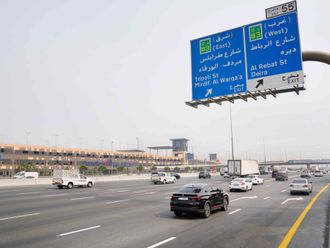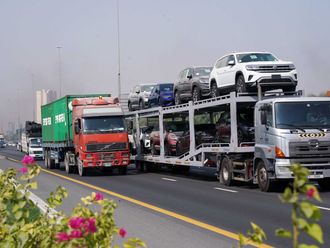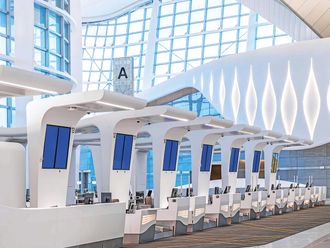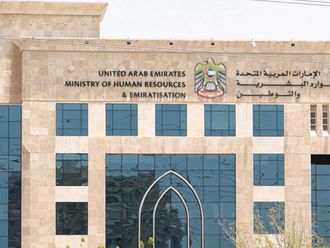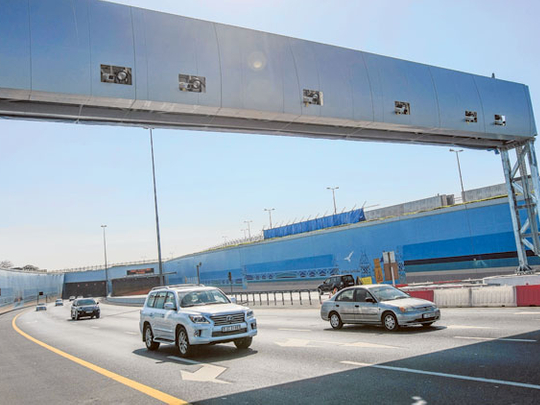
Dubai: The introduction of two new Salik toll gates aims at reducing traffic congestion in the emirate and to ensure smooth traffic between Dubai and Sharjah.
Two more Salik toll gates will be operational in Dubai with effect from April 15 this year, said a top official at the Roads and Transport Authority (RTA).
One of the Salik gates is being installed near Al Mamzar Bridge on Al Ittihad Road — the busiest highway between Dubai and Sharjah — while the second one will be put up at the entrance and exit of the Airport Tunnel on Beirut Road in Al Twar side.
Salik gates have been installed on both sides (before and after) the Al Mamzar Bridge on Ittihad Road but the motorists will be charged only once even if they cross both the gates.
“The new gates are being installed as part of the phase 3 of the Salik toll gate system which aims at ensuring smooth traffic flow in Dubai,” said Mattar Al Tayer, Chairman of the Board and Executive Director of the RTA in a statement on Thursday.
About 1,500 vehicles are expected to be diverted from Al Ittihad and Beirut Roads to the Shaikh Mohammad Bin Zayed Road (Emirates Road) and the Bypass Road, said Al Tayer.
Motorists will have to pay Dh4 each time they drive through the Salik gates. Currently, there are four Salik toll gates in Dubai including one each on Al Garhoud Bridge and Al Maktoum Bridge, and two on Shaikh Zayed Road — A Safa Salik Toll Gate and Al Barsha Salik Toll Gate.
The Salik toll system was first introduced in Dubai in 2007 with two gates. Two more gates were added in September 2008.
Al Tayer said the new Salik gates were introduced after conducting exhaustive traffic and field studies of the first and second phases.
He said that Al Ittihad Road is considered one of the busiest roads in Dubai as an average of 260,000 vehicles use it daily with an estimated three million trips per day. The number of vehicles using Al Ittihad Road is nine per cent of the total travelling in the Emirate.
“The RTA has spent around one billion dirham in upgrading Al Ittihad Road through constructing a number of flyovers and additional tunnels. However, the service levels remained below the international standards, given the massive demand for this vital corridor; which is one of the key roads in the Emirate,” noted Al Tayer.
He said the traffic congestion on Al Ittihad Road impacts a wide network of roads in Dubai, and the bottlenecks of Al Ittihad Road spill over to all other key intersections of this vital corridor such as Abu Hail, Al Nahda, Airport, Al Maktoum, and Al Muraqqabat Roads.
“The traffic studies concluded that the installation of a toll gate system on Al Ittihad Road without installing the system on the Airport Tunnel will result in massive traffic congestions in the Airport Tunnel,” he added.
He said the Airport Tunnel is also considered one of the key roads that serve the Dubai International Airport, particularly as the Civil Aviation Authority in Dubai has embarked on a massive expansion of the Dubai International Airport such that it will have the capacity to handle 110 million passengers per annum by 2020.
“This means that the existing traffic jam on the Airport Tunnel will aggravate rapidly in case no express traffic solutions are figured out. Since there is no way to widen the Tunnel from an engineering perspective, the only solution is to introduce Salik to divert a portion of traffic to alternative roads such as the Shaikh Mohammad Bin Zayed Road, and the Dubai Bypass Road.
The decision, he added, had been taken after the lapse of more than one year since the operation of the Green Line of the Dubai Metro, and more than three years since the operation of the Red Line of the Dubai Metro. It also comes after the deployment of a sprawling network of public buses network and the opening of Al Khail Road Widening and Improvement Project.
The study also included examining the traffic congestions which are still being experienced by key roads in the emirate, and formulating appropriate solutions and alternatives for them.



